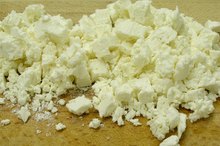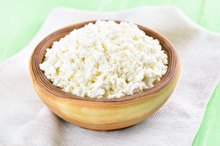What does fact checked mean?
At Healthfully, we strive to deliver objective content that is accurate and up-to-date. Our team periodically reviews articles in order to ensure content quality. The sources cited below consist of evidence from peer-reviewed journals, prominent medical organizations, academic associations, and government data.
- National Digestive Diseases Information Clearinghouse: What I Need to Know About Lactose Intolerance
The information contained on this site is for informational purposes only, and should not be used as a substitute for the advice of a professional health care provider. Please check with the appropriate physician regarding health questions and concerns. Although we strive to deliver accurate and up-to-date information, no guarantee to that effect is made.
Cheddar Cheese & Diarrhea
If you have suffered the consequences of lactose-intolerance, you may be afraid to include any dairy in your diet. However, dairy is an excellent source of calcium, and even if milk doesn't agree with you, it is still a good idea to have some yogurt or cheese in your diet. Aged-cheddar is a great option for the lactose-intolerant because much of the lactose is digested by bacteria during the cheese-making process.
If you are experiencing serious medical symptoms, seek emergency treatment immediately.
Lactose Intolerance
Lactose is a sugar from dairy digested in the small intestine by the enzyme lactase. If your body has low levels of this enzyme, lactose travels down the gastrointestinal tract undigested. Intact lactose eventually arrives at the colon, where it draws in water. The result is watery diarrhea, often accompanied by painful cramps, gas and bloating.
Many individuals have an impaired ability to digest lactose to some degree. You may be able to tolerate a little milk in your cereal, whereas a large glass would send you running to the bathroom. Compared to other cheeses, cheddar cheese has a low concentration of intact lactose, making it easier to tolerate.
- Lactose is a sugar from dairy digested in the small intestine by the enzyme lactase.
- Compared to other cheeses, cheddar cheese has a low concentration of intact lactose, making it easier to tolerate.
Lactose in Cheddar Cheese
Does Greek Yogurt Cause Lactose Intolerance?
Learn More
One and a half ounces of cheddar cheese has only about 1 g of lactose. Compare this to a cup of milk, with 9 to 14 g of lactose, and you can see why hard cheeses are better tolerated by most people. The portion of dairy that contains the most lactose is whey. During the production of cheddar cheese, whey is removed. Cheeses that are aged 3 to 4 weeks or more contain very little lactose.
- One and a half ounces of cheddar cheese has only about 1 g of lactose.
- Cheeses that are aged 3 to 4 weeks or more contain very little lactose.
Low Lactose Options
Additional diary options for the lactose-intolerant include other aged cheeses, like Swiss or parmesan. Most yogurt is also easier to handle because bacteria help breakdown some of the natural sugars. Look for yogurts that contain "live active cultures." Try having small portions of dairy, spaced throughout the day. Certain brands of milk are designed to contain predigested lactose. Manufacturers add the enzyme lactase to help break down lactose before you drink it.
Non-dairy products like soy, almond, and rice milk can also be a great source of calcium. Check the label to be sure these products are fortified with calcium. Tofu, broccoli, salmon with bones and dark leafy greens also have calcium. Talk to your doctor or a registered dietitian to find out if you are getting enough calcium from food, or if you should consider a supplement.
- Additional diary options for the lactose-intolerant include other aged cheeses, like Swiss or parmesan.
The Joys of Cheddar Cheese
Buttermilk and Lactose
Learn More
Managing lactose intolerance is all about making sure you do not consume more lactose at one time than your body can handle. Trial and error can help you determine what amount and types of food will work for you. Because cheddar cheese is so low in lactose, try having small portions with meals and snacks. Cheddar cheese cubes are great with grapes and whole wheat crackers for a snack. Melt cheddar cheese in a tortilla or add cheddar cheese crumbles to your salad. However you choose to have it, cheddar cheese can be a great option for the lactose intolerant, just don't eat too much at once.
- Managing lactose intolerance is all about making sure you do not consume more lactose at one time than your body can handle.
- However you choose to have it, cheddar cheese can be a great option for the lactose intolerant, just don't eat too much at once.
Related Articles
References
- Malik TF, Panuganti KK. Lactose Intolerance. [Updated 2019 Feb 22]. In: StatPearls [Internet]. Treasure Island (FL): StatPearls Publishing; 2019 Jan-. Available from: https://www.ncbi.nlm.nih.gov/books/NBK532285/
- Xiong L, Wang Y, Gong X, Chen M. Prevalence of lactose intolerance in patients with diarrhea-predominant irritable bowel syndrome: data from a tertiary center in southern China. J Health Popul Nutr. 2017;36(1):38. Published 2017 Nov 21. doi:10.1186/s41043-017-0113-1
- InformedHealth.org [Internet]. Cologne, Germany: Institute for Quality and Efficiency in Health Care (IQWiG); 2006-. Causes and diagnosis of lactose intolerance. 2010 Sep 15 [Updated 2018 Nov 29]. Available from: https://www.ncbi.nlm.nih.gov/books/NBK310263/
- Brill H. Approach to milk protein allergy in infants. Can Fam Physician. 2008;54(9):1258–1264.
- National Institutes of Health. Lactose Intolerance: Information for Health Care Providers. U.S. Department of Health and Human Services. Eunice Kennedy Shriver National Institute of Child Health and Human Development. NIH Publication January 2006.
- Lapides RA, Savaiano DA. Gender, Age, Race and Lactose Intolerance: Is There Evidence to Support a Differential Symptom Response? A Scoping Review. Nutrients. 2018;10(12):1956. Published 2018 Dec 11. doi:10.3390/nu10121956
- Szilagyi A, Ishayek N. Lactose Intolerance, Dairy Avoidance, and Treatment Options. Nutrients. 2018;10(12):1994. Published 2018 Dec 15. doi:10.3390/nu10121994
- Szilagyi A, Galiatsatos P, Xue X. Systematic review and meta-analysis of lactose digestion, its impact on intolerance and nutritional effects of dairy food restriction in inflammatory bowel diseases. Nutr J. 2016;15(1):67. Published 2016 Jul 13. doi:10.1186/s12937-016-0183-8
- Ghoshal UC, Kumar S, Chourasia D, Misra A. Lactose hydrogen breath test versus lactose tolerance test in the tropics: does positive lactose tolerance test reflect more severe lactose malabsorption?. Trop Gastroenterol. 2009;30(2):86-90.
- Deng Y, Misselwitz B, Dai N, Fox M. Lactose Intolerance in Adults: Biological Mechanism and Dietary Management. Nutrients. 2015;7(9):8020–8035. Published 2015 Sep 18. doi:10.3390/nu7095380
- Sethi S, Tyagi SK, Anurag RK. Plant-based milk alternatives an emerging segment of functional beverages: a review. J Food Sci Technol. 2016;53(9):3408–3423. doi:10.1007/s13197-016-2328-3
- Mahoney R.R. (1997) Lactose: Enzymatic Modification. In: Fox P.F. (eds) Advanced Dairy Chemistry Volume 3. Springer, Boston, MA
- Mill D, Dawson J, Johnson JL. Managing acute pain in patients who report lactose intolerance: the safety of an old excipient re-examined. Ther Adv Drug Saf. 2018;9(5):227–235. doi:10.1177/2042098617751498
- InformedHealth.org [Internet]. Cologne, Germany: Institute for Quality and Efficiency in Health Care (IQWiG); 2006-. Lactose intolerance: Shopping tips for lactose-intolerant people. 2010 Sep 15 [Updated 2018 Nov 29]. Available from: https://www.ncbi.nlm.nih.gov/books/NBK310258/
- Hodges JK, Cao S, Cladis DP, Weaver CM. Lactose Intolerance and Bone Health: The Challenge of Ensuring Adequate Calcium Intake. Nutrients. 2019;11(4)
- Li K, Wang XF, Li DY, et al. The good, the bad, and the ugly of calcium supplementation: a review of calcium intake on human health. Clin Interv Aging. 2018;13:2443–2452. Published 2018 Nov 28. doi:10.2147/CIA.S157523
- Mcbean LD, Miller GD. Allaying fears and fallacies about lactose intolerance. J Am Diet Assoc. 1998;98(6):671-6.
- The National Digestive Diseases Information Clearinghouse. ”Lactose Intolerance.” National Institute of Diabetes and Digestive and Kidney Diseases Jun 2014.
- US Food and Drug Administration. "Problems Digesting Dairy Products?” FDA.gov 4 March 2009.
Writer Bio
Anastasia Climan is a registered dietitian and active member of the Academy of Nutrition and Dietetics. Her experience includes managing a medical nutrition grant for HIV, developing menus for local preschools and coaching clients on nutrition through her business, The Princess Prescription. Her numerous articles have appeared on Jillian Michaels and other health sites.









